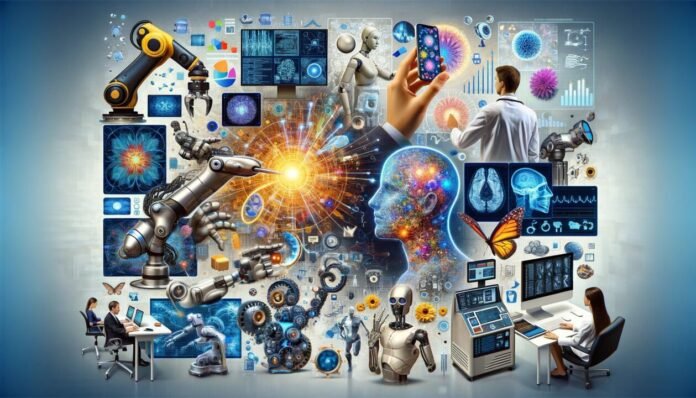Understanding Multimodal Generative AI
Multimodal generative AI (GenAI) represents a transformative shift in the landscape of artificial intelligence, aimed at significantly expanding the capabilities of existing systems. Unlike traditional generative AI models, which typically specialize in a single mode of data—be it text, images, audio, or video—multimodal AI can seamlessly process and integrate multiple data types within a unified architecture. This capability fosters a more holistic understanding of information, enabling more sophisticated applications that cater to diverse user needs.
The evolution of multimodal Generative AI is evidenced by statistics from Gartner analysts, who predict a substantial increase in the use of these systems. Currently, it is estimated that a mere 1% of generative AI systems exhibit multimodal capabilities. However, by the year 2027, this figure is anticipated to rise dramatically to 40%. Such a trend highlights a noteworthy shift toward integrating varied data formats, making AI more versatile and user-centric.
Traditional models have often faced limitations due to their focus on individual modalities, which restricts their ability to analyze complex scenarios that involve multiple data elements. For instance, a text-based model may struggle to interpret the full context of an image without supplementary information from other sources. In contrast, multimodal GenAI can analyze text, audio, and visual content concurrently, leading to enriched comprehension and interaction. This advancement not only enhances user experiences but also opens new avenues for innovation in fields such as education, entertainment, and healthcare.
As the industry continues to evolve, understanding the implications of multimodal generative AI becomes increasingly essential for businesses and technology leaders alike. By leveraging the strengths of varied data inputs, organizations can look forward to more comprehensive solutions that effectively address complex challenges in the digital age.
The Shift from Individual to Multimodal Models
The transition from individual data models to multimodal systems marks a significant shift in the landscape of artificial intelligence. Traditionally, AI has relied on singular data modalities, processing information from text, images, or audio in isolation. However, multimodal generative AI integrates and analyzes data from various streams, allowing for a deeper understanding of complex interactions and relationships. This integration enhances human-AI interaction, resulting in more intuitive and efficient user experiences.
Insights from Gartner analyst Erick Brethenoux highlight the transformative potential of multimodal generative AI. He emphasizes that such systems can recognize and leverage the intricate connections between different data types. For instance, by combining visual and textual understanding, AI can generate more contextually relevant outputs. This capability is particularly beneficial in sectors like healthcare, marketing, and customer service, where understanding nuanced relationships can lead to improved decision-making and service delivery.
The anticipated rise of autonomous agents is one notable innovation stemming from this shift. These agents utilize multimodal generative AI to execute tasks across diverse environments, functioning as sophisticated assistants that adapt to varying scenarios and user needs. For example, in a customer support context, an autonomous agent could analyze a customer’s spoken inquiries along with visual data from product images, providing tailored solutions that enhance the overall service experience.
As organizations begin to adopt multimodal AI systems, the potential to transform workflows and improve efficiency becomes apparent. By facilitating more comprehensive data interpretation, these technologies foster a more interactive and responsive AI that aligns closely with human cognitive processes. Ultimately, this shift not only improves the capabilities of AI but also enriches the user experience across various applications.
The Competitive Advantage of Multimodal GenAI
In recent years, the emergence of multimodal generative AI (GenAI) has become a focal point for organizations seeking to gain a competitive edge in their respective markets. Unlike traditional generative AI, which typically operates within a single modality—such as text or image—multimodal GenAI systems integrate multiple data types, enabling richer and more nuanced understanding and generation of content. This capability allows businesses to harness complex insights from diverse sources, fundamentally transforming how they engage with customers and make strategic decisions.
Gartner analysts predict a substantial rise in the adoption of multimodal GenAI technologies, projecting that organizations will begin to recognize their transformative potential within the next few years. By integrating multimodal capabilities, companies can streamline operations, enhance customer experiences, and foster innovation. For instance, firms leveraging multimodal GenAI can analyze user interactions through text, audio, and visual content to better tailor their offerings, leading to improved customer satisfaction and loyalty.
The anticipated peak of the hype curve for multimodal systems suggests that we are on the brink of a significant shift in market dynamics. Companies employing multimodal generative AI, such as Aleph Alpha, exemplify how integrating these advanced capabilities can lead to remarkable outcomes. Their Luminous model exemplifies the integration of diverse input forms, enriching customer-centric AI systems and enabling users to interact seamlessly across various modalities. Moreover, platforms like ChatGPT are pioneering customization, allowing organizations to tailor generative AI outputs according to specific user needs, thereby elevating the relevance of interactions.
As organizations continue to explore the competitive advantages offered by multimodal Generative AI, it becomes increasingly clear that those who harness this technology early will not only improve operational efficiencies but also redefine engagement strategies in an increasingly complex digital landscape.
Future Prospects and Applications of Multimodal GenAI
The future of multimodal generative AI (GenAI) is poised for transformative developments across various industries. This innovative technology, which leverages multiple forms of data—such as text, images, and audio—allows organizations to harness richer insights and achieve more robust outcomes. As highlighted by Gartner analysts, the anticipated advancements over the next five years will usher in a paradigm shift in how businesses operate, moving workforce roles from purely deployment-focused tasks to more nuanced responsibilities centered on monitoring and optimization of GenAI systems.
One of the most significant applications of multimodal GenAI lies in enhancing decision-making processes. By integrating diverse data types, organizations can gain a holistic understanding of their operational landscape. This integrated approach minimizes the risks associated with relying on a single modality, thus fostering more informed decisions. Industries ranging from healthcare, where patient data can be analyzed through imaging and clinical notes, to marketing, where customer interactions can be assessed across social media and direct feedback channels, will benefit considerably from this technology.
As noted by Brethenoux, the ability to comprehend and synthesize information across multiple modalities is not just advantageous but essential. Organizations must adapt to this integrated approach to remain competitive and responsive to dynamic market needs. Additionally, adopting multimodal GenAI solutions can lead to substantial cost savings, as these systems can automate numerous tasks, driving efficiency and reducing resource expenditures. Consequently, the future landscape indicates that those organizations embracing multimodal GenAI will not only enhance their operational efficiency but will also position themselves as leaders in innovation.
In conclusion, the integration of multimodal generative AI into various sectors signifies a pivotal evolution in the way businesses leverage technology, making it imperative for organizations to adapt and capitalize on these emerging tools.





